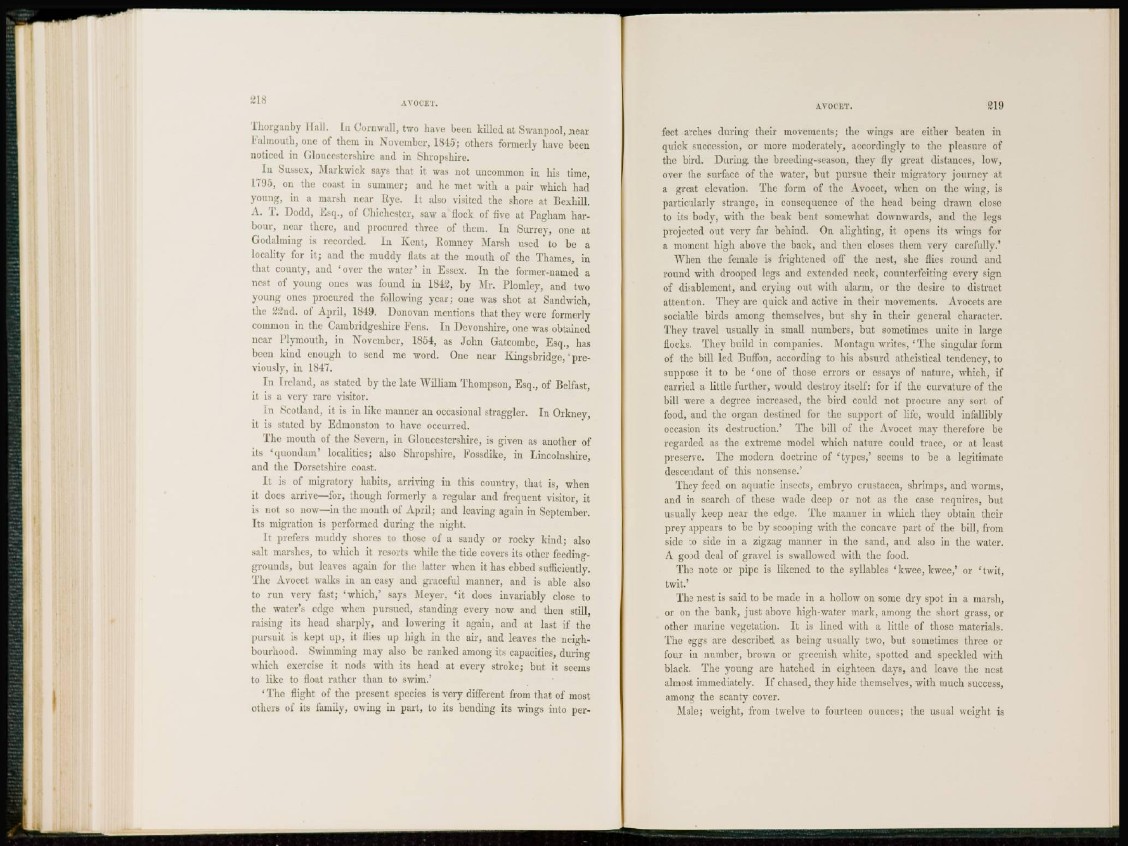
AVOCET.
Thorgaaby Sail. In Cornwall, two have been killed a t Swanpool, near
Falmouth, one of them in November, 1815; others formerly have been
noticed in Gloucestershire and in Shropshire.
In Sussex, Markwick says that it was not uncommon in his time,
1790, on the coast in summer; and he met with a pair which had
young, in a marsh near Rye. It also visited the shore at Bexhill.
A. T. Dodd, Esq., of Chichester, saw a flock of five at Pagham harbour,
near there, and procured three of them. In Surrey, one at
Godalraing is recorded. In Kent, Romncy .Marsh used to be a
locality for it; and the muddy flats at the mouth of the Thames, in
that county, and 'over the water* in Essex. In the former-named a
nest of young ones was found in 1812, by Mr. Plomley, and two
young ones procured the following year; one was shot at Sandwich,
tin 22nd. of April, 1819. Donovan mentions that they were formerly
common in the Cambridgeshire Fens. In Devonshire, one was obtained
near Plymouth, in November, 1851, as John Gatcombe, Esq., has
been kind enough to send me word. One near Kingsbridgc,1 previously,
in 1817.
I n Ireland, as stated by the late William Thompson, Esq., of Belfast,
il is a very rare visitor.
In Scotland, it is in like manner an occasional straggler. In Orkney,
it is stated by Edmonston to have occurred.
The mouth of the Severn, in Gloucestershire, is given as another of
its 'quondam' localities; also Shropshire, Fossdikc, in Lincolnshire,
and the Dorsetshire coast.
I t is of migratory habits, arriving in this country, that is, when
it docs arrive—for, though formerly a regular and frequent visitor, it
is not so now—in the month of April; and leaving again in September.
Its migration is performed during the night.
It prefers muddy shores to those of a sandy or rocky kind; also
salt marshes, to winch it resorts while the tide covers its other feedinggrounds,
but leaves again for the latter when it has ebbed sufficiently.
The Avocct walks in an easy and graceful manner, and is able also
to run very fast; 'which,' says Meyer, 'it does invariably close to
the water's edge when pursued, standing every now and then still,
raising its head sharply, and lowering it again, and at last if the
pursuit is kept up, it flies up high in the air, and leaves the neighbourhood.
Swimming may also be ranked among its capacities, during
which exercise it nods with its head at every stroke; but it seems
to like to float rather than to swim.'
' The flight of the present species is very different from that of most
others of its family, owing in part, to its bending its wings into per-
AYOCET. 219
feet arches during their movements; the wings are either beaten in
quick succession, or more moderately, accordingly to the pleasure of
the bird. During, the breeding-season, they fly great distances, low,
over the surface of the water, but pursue their migratory journey at
a great elevation. The form of the Avocet, when on the wing, is
particularly strange, in consequence of the head being drawn close
to its body, with the beak bent somewhat downwards, and the legs
projected out very far behind. On alighting, it opens its wings for
a moment high above the back, and then closes them very carefully.'
When the female is frightened off the nest, she flics round and
round with drooped legs and extended neck, counterfeiting every sign
of disablement, and crying out with alarm, or the desire to distract
attention. They are quick and active in their movements. Avocets are
sociable birds among themselves, but shy in their general character.
They travel usually in smaU numbers, but sometimes unite in large
flocks. They build in companies. Montagu writes, ' T h e singular form
of the bill led Buffbn, according to his absurd atheistical tendency, to
suppose it to be 'one of those errors or essays of nature, which, if
carried a little further, would destroy itself: for if the curvature of the
bill were a degree increased, the bird could not procure any sort of
food, and the organ destined for the support of life, would infallibly
occasion its destruction.' The bill of the Avocet may therefore be
regarded as the extreme model which nature could trace, or at least
preserve. The modern doctrine of 'types,' seems to be a legitimate
descendant of this nonsense.'
They feed on aquatic insects, embryo Crustacea, shrimps, and worms,
and in search of these wade deep or not as the case requires, but
usually keep near the edge. The manner in which they obtain their
prcy appears to be by scooping with the concave part of the bill, from
side to side in a zigzag manner in the sand, and also in the water.
A good deal of gravel is swallowed with the food.
The note or pipe is likened to the syllables 'kwee, kwee,' or 'twit,
twit.'
The nest is said to be made in a hollow on some dry spot in a marsh,
or on the bank, just above high-water mark, among the short grass, or
other marine vegetation. It is lined with a little of those materials.
The eggs are described as being usually two, but sometimes three or
four in number, brown or greenish white, spotted and speckled with
black. The young are hatched in eighteen days, and leave the nest
almost immediately. If chased, they hide themselves, with much success,
among the scanty cover.
Male; weight, from twelve to fourteen ounces; the usual weight is